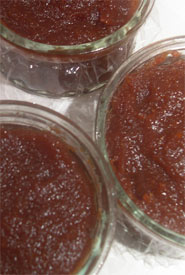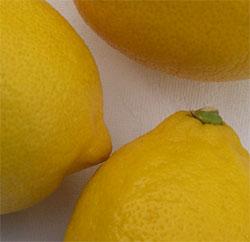Easy quince cheese recipe (membrillo)
Posted by Fiona Nevile in Fruit, Jam Jelly and Preserves, Vegetarian | 156 comments I’m back at the helm and it’s marvellous to be feeling well and chirpy and slimmer. Forget Champneys. A week in bed with a bug does wonders for the figure.
I’m back at the helm and it’s marvellous to be feeling well and chirpy and slimmer. Forget Champneys. A week in bed with a bug does wonders for the figure.
Danny put on his sensible parent hat this morning. He instructed me not to go to work, reasoning that more recuperation was required. He was right. I did feel weak.
This afternoon, he relented slightly.
“Why not go out foraging for an hour. You could do with some fresh air.”
He passed me the foraging stick, tossed me his car keys and disappeared upstairs.
I found some plump sloes and with the help of the walking stick accessed branches that only a seven foot giant could reach. The crab apple tree had a small final harvest. Being north facing its fruit had not spoiled. I tootled home and simmered the crab apples with chillies to make a hot jelly (recipe later this week if it turns out well).
My main aim today was to make some quince cheese. The quinces had been cooked and strained for jelly the week before last. The juice and flesh keep well in the fridge for up to two weeks. Today was the last day.
When I discovered membrillo at the Spanish Deli in Portobello Road I was delighted. I love the combination of membrillo and Manchego. Danny wasn’t impressed. His face crumpled when he tasted it.
“It’s so sweet. How can you like it?”
I was pretty sure that membrillo needn’t be so sweet. I looked at various recipes on the internet. The amount of sugar varied enormously. In the end I decided to plump for an equal volume of quince pulp to sugar. This has produced a membrillo that is sweet but tastes of quince. I reckon that one could get away with even less sugar in fact when I looked in my copy of Oded Schwartz, his recipe uses slightly less – 50g less. Adding the lemon juice made a difference too.
They key to this recipe is time. I simmered the quinces for at least three hours until they became a deep pink colour. The final stage is a long process too. The quince pulp and sugar was simmered gently (lowest setting) for a good 2-3 hours to intensify the colour and thicken the pulp to the right consistency. There is no need to bring the mixture to a rolling boil. This is a recipe that is spread over two evenings. One evening simmer the quinces and strain overnight. The next evening make the membrillo.
Danny tasted it gave the recipe the thumbs up, especially when he realised that the by product is the juice for quince jelly.
Easy quince cheese recipe (membrillo)
Ingredients:
For the quince pulp:
- 1 kilo of quinces
- Zest of half a lemon
- Water to cover
For the quince cheese:
- Quince pulp
- Juice of half a lemon
- Granulated (not castor) white sugar (equal volume to the pulp)
Method:
- Rub the down off the quinces and wash them. There is no need to peel or core the quinces.
- Chop the quinces carefully, as they are hard it is easy for the knife to slip. I chopped them into quarters and sliced them into 1cm slices.
- Place the quince slices in a large saucepan or casserole dish and add water so that they are just floating. Add the zest of half a lemon.
- Bring slowly to the boil and then turn the hob down to it’s lowest setting so that the quinces gently simmer (lid on). Simmer the fruit until very soft and the fruit has turned a deep pink colour. This took me about 3 hours. Check the quinces every now and then and top up the water if necessary.
- Strain the juice from the fruit overnight using a jelly bag or muslin square. Retain the juice to make quince jelly.
- I was loathe to spend hours pressing the quinces through a sieve so I put them through the Magimix
(medium grater blade) and then I sieved them.
- Measure the pulp using a measuring jug put the pulp into a large heavy bottomed saucepan or casserole dish and add an equal volume of white granulated sugar. Add the juice of half a lemon.
- Bring the pulp and sugar gradually to simmering point, stirring to dissolve the sugar and let it simmer, lowest setting for 2-3 hours, stirring every now and then to stop it sticking and burning. It will resemble gloopy mud. Gradually the colour will darken. Eventually the fruit will become very thick (I could stand my spoon up in mine).
- Spoon into well oiled sterilised straight sided jars and seal with cellophane lids. This will keep for months. Cut slices to eat with cheese or cold meat. Refrigerate after opening.
Leave a reply






Can membrillo freeze? I had a good croop of quinces this year, and as my membrillo turns up beautifully well, I decided to make the lot and freeze if possible. Please help somebody!!!!
Hi Irene
Thanks for dropping by.
What a great idea using the cling film! I love the idea of the towers.
Great to hear that you had a productive day in the kitchen. Onion marmalade is on my list too.
Hi,
Well I’ve made the quince jelly – turned out perfect and I have made the Membrillo, pound for pound pulp and sugar with a little lemon juice and simmered for three hours, which turned out equally as good. I used oiled cling film on a baking tray on which I placed oiled chefs rings and then filled them with the Membrillo. Once the Membrillo was slightly set on top, I placed an oiled piece of cling film over it, in which to wrap the tower of Membrillo, turned the ring over and the small tower just slipped out of the ring and I now have these small towers of soft Membrillo, wrapped in film and ready to slice or freeze and with no jar to manoeuvre.
I was on a roll today and also made onion marmalade, chocolate brownies and pureed the last of my Grnadier cookers, now off to put my feet up and have a cup of tea!
Hi Clare,
I reckon that your quinces were a good buy.
I cut up the quinces cores and all and simmered them to strain for jelly. I put the strained pulp though the magimix before putting it through the sieve. Easy.
Yes, the membrillo can be poured into a tray (well greased) and covered with greaseproof paper to dry (in the oven) or on a sunny windowsill for a day. It is then cut up and dusted with sugar. Cover with greaseproof paper to dry It should keep for months in an airtight container with greaseproof paper in between the layers.
I just put it into jars as I wanted a softer membrillo to eat with savoury things.
Hi Sally,
I think that the membrillo would work well in your chicken and porcini dish. I’d love to hear how it works out.
Today was Quince day in our part of Niccone Valley Umbria. I have made the jelly and a jar of cheese from the pulp. However I am wondering if I could use the paste in a stuffed boned chicken leg with some porchini…results later in the week.
How nice to find other quince maniacs! Went to ludlow market in Shropshire yesterday and bought the whole box of quinces – it cost me £10 for the lot (about 5kilos) but worth every penny, I think!! They’re pretty small, but will still be fantastic I think. Have made jelly before, but never the membrillo – how do you get the pips/cores out – or do you just puree the lot in the magimix and then sieve it?? Also, I’ve seen (in France, I think) membrillo cut into cubes and dusted with caster sugar. do you think that if I made it now, and layered it carefully with greaseproof paper, it would keep til christmas for presents, or should I somehow freeze the pulp? Generally I think if there’s that much sugar, it should be ok and not go mouldy? I fancy boxing up the little cubes as a present for like-minded gourmands.
Hi Irene,
Glad that you are enjoying the site. Our japonica quinces were not so good this year either but we had far more quinces on our young quince tree.
I have no idea whether white rowan berries are edible. I suspect they are but cannot find a definite answer. Sorry.
Hi,
Nice website, have just picked my japonica quince and am rarin’ to go, I’ll try the cheese too, it looks good. My last years jelly is just finished but this years crop wasn’t nearly so prolific and I doubt if it will last as long!! Also, I have just made crab apple jelly and chucked the pulp, oh no, don’t tell me I could have made cheese with it or I will be foraging in the bin! I have white berries in my rowan trees, can I make jelly from them as well as from the red ones, does anyone know?
Hi Claire,
I find that an equal volume of pulp to sugar works best for me as it is not too sweet. The secret of the colour is long cooking time.
I am lucky having my own (young) quince tree and also I have a friend with a more mature tree.
Hi Mildred,
Yes I totally agree the fine sieve and the long cooking time make all the difference. Also a lot of recipes tell you to put it in treys to dry on a sunny windowsill and then cut the membrillo into squares. I wanted mine to be in little pots so I skipped this bit.
Hi Claire,
Great news that that you got a better membrillo. Manchego/Membrillo is an acquired taste. Danny isn’t keen either. Membrillo is great with yoghurt or soft goats cheese or just on its own, dried and cut up and rolled in sugar as a sweetmeat.
I made more and I think it worked!! I only used one quince and I cooked it much much longer after it had been pureed. I think I didn’t let it go far enough the first time because I was afraid of over cooking, but having done it correctly, I can see you can tell when it’s ready. Very excited. Not sure what to do with it now. I tried manchego and didn’t really like it. The membrillo is so pretty though, that I don’t even feel like I need to eat it to justify it’s existence.
Thanks, Mildred. I think you might be right about the quince becoming the next big thing. How could it not–it has such personality.